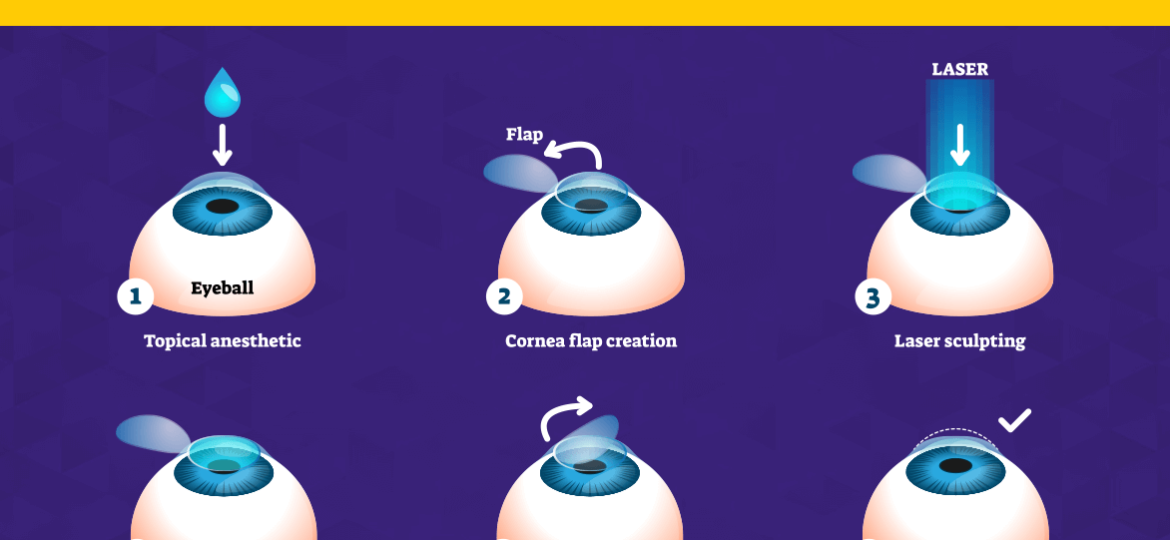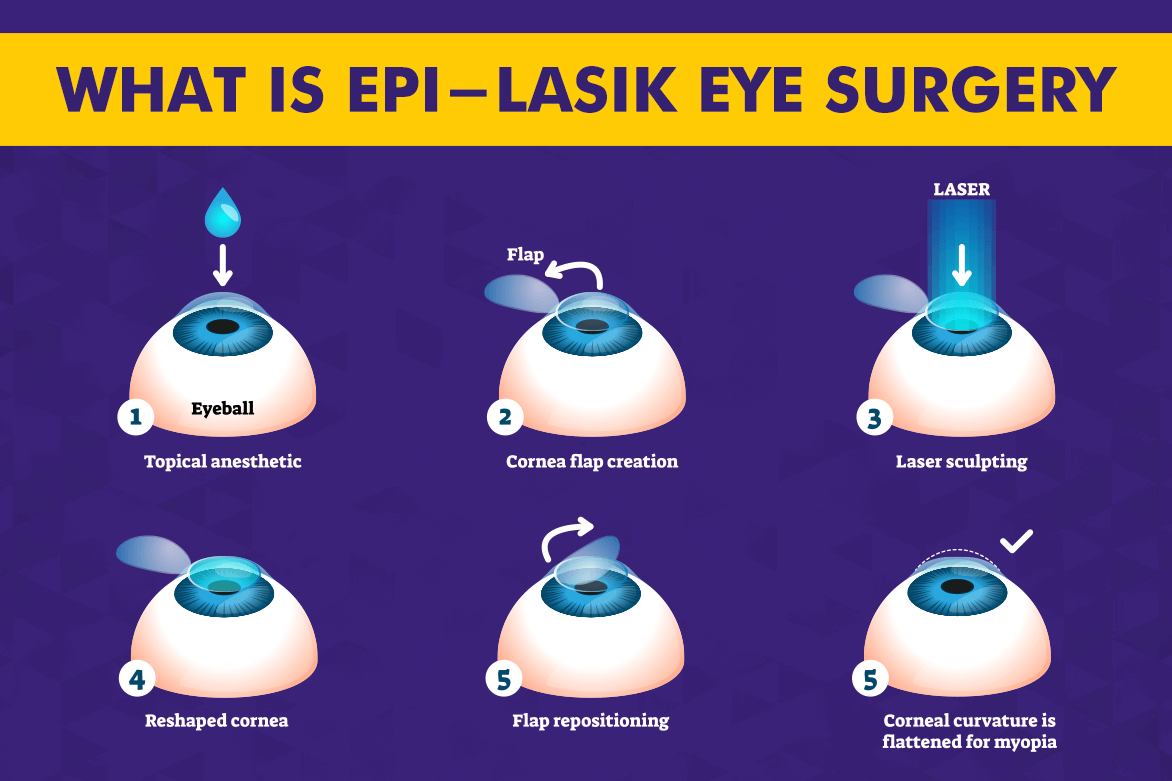
What is Epi-LASIK Eye Surgery & How it Works?

Who doesn’t yearn for a perfect vision? To be able to wake up without the urge to find your glasses—it’s a dream for many people who are going through some sort of visionary impairment. In this struggle for perfect vision, people find themselves at the crossroads of decision-making—weighing the pros and cons of corrective eye surgery. Amidst an array of options available globally, Epi LASIK emerges as the first resort for those seeking liberation from glasses and contact lenses. This advanced procedure has proven to make incredible strides in ophthalmology, promising a future where the world is viewed through a clearer lens.
Let’s find out what Epi LASIK eye surgery entails, the processes involved during and after the surgery, eligibility criteria, benefits, risks, the cost of the surgery, and much more.
What is Epi-LASIK?
Epi LASIK eye surgery, or Epithelial Laser In Situ Keratomileusis, is a sophisticated evolution in refractive procedures. It is a type of refractive surgery, similar to LASIK, designed to correct vision and reduce a person’s dependency on glasses or contact lenses. This procedure is particularly suited for individuals with myopia (nearsightedness), hyperopia (farsightedness), and astigmatism. Epi LASIK combines elements from LASIK and PRK (photorefractive keratectomy), offering an alternative for those who may not be suitable candidates for traditional LASIK due to certain corneal considerations.
Epi LASIK offers a viable option for patients seeking to improve their vision while minimizing the risks associated with cutting a deeper corneal flap or those who have thinner corneas that make them less ideal candidates for LASIK eye surgery.
Know more on : Lasik Eye Surgery Eligibility
Epi LASIK Procedure
The Epi LASIK procedure is a refined approach to vision correction that combines elements of LASIK and PRK, offering an effective solution for patients with myopia, hyperopia, and astigmatism. Here’s a step-by-step overview of the Epi LASIK surgery procedure:
You can also read about PRK Vs LASIK
Before Epi LASIK Procedure
- Diagnosis and Tests
The journey towards Epi LASIK begins with a thorough consultation and comprehensive eye examination. During this phase, the ophthalmologist runs several tests like retinal evaluation, corneal composition, shape, and thickness, intraocular pressure etc, to evaluate the overall health of the eyes.
- Pre-Surgical Preparation
Once deemed a suitable candidate, patients receive instructions to prepare for surgery. This often includes discontinuing the use of contact lenses for a period (usually around 1-2 weeks before the procedure) to allow the cornea to return to its natural shape. Patients may also be advised to avoid makeup, lotions, or perfumes on the day of surgery to reduce the risk of infection.
During Epi LASIK Procedure
- Anesthetic and Epithelial Separation
To ensure a pain-free experience during the procedure, numbing eye drops are gently applied to the eye. A special tool, known as an epithelial separator, is then carefully used to lift a delicate, ultra-thin layer of the cornea’s surface layer. This layer is gently moved to one side, allowing clear access to the cornea beneath.
- Laser Reshaping
With the surface layer out of the way, a precise excimer laser comes into play, meticulously reshaping the cornea underneath to correct the vision. Once this reshaping is complete, the corneal surface layer is delicately put back in its original spot.
- Repositioning the Epithelial Flap
To aid in the healing process and protect the eye, a soft bandage contact lens is placed over the cornea. This stays on for a few days, giving the cornea and newly forming cells enough time to securely reattach and cover the treated area. Once healing has sufficiently progressed, this protective lens is carefully removed.
After Epi LASIK Procedure
- Initial Recovery
Post-surgery, patients may experience mild discomfort and sensitivity to light, which generally improve within a few days. A bandage contact lens is placed on the eye to facilitate healing, typically removed after up to a week.
- Follow-up Visits
Essential follow-up appointments allow the surgeon to monitor healing and address any concerns. These visits are critical for ensuring a smooth recovery and achieving optimal visual outcomes.
- Visual Recovery
Vision improvement is often noticeable within days, but final results can take several weeks to months. Adhering to post-operative care instructions, including the use of prescribed eye drops, is vital for preventing complications and supporting the healing process.
Do’s and Don’ts Post Epi-LASIK Surgery
Here’s a crisp table summarizing the Do’s and Don’ts post-Epi LASIK eye surgery:
| Do’s | Don’ts |
| Follow your surgeon’s instructions | Rub or touch your eyes |
| Wear sunglasses outdoors | Expose your eyes to water (pools, hot tubs, etc.) |
| Attend all follow-up appointments | Engage in strenuous activities or contact sports |
| Rest your eyes adequately | Skip your medication regimen |
| Maintain good eye hygiene | Use makeup, lotions, or creams around your eyes |
Benefits of Epi-LASIK Surgery
Epi LASIK surgery offers several benefits for individuals seeking to correct their vision and reduce dependence on glasses or contact lenses. Here are some of the key advantages:
- Less Pain After Surgery
People who get Epi LASIK often say it doesn’t hurt much, especially in the first few days after the surgery.
- Good Vision Comes Quickly
In about a month, people who have Epi LASIK catch up to those who had other types of eye surgery, seeing just as well.
- Fewer Foggy Vision Issues
Down the road, six months to a year later, people notice less blurriness or cloudiness in their vision compared to other surgeries.
- Speedy Procedure
Epi LASIK is fast! It takes just a few minutes per eye, so you’re in and out quickly compared to other eye surgeries.
Epi LASIK Healing time & Recovery
Epi LASIK healing time and recovery period typically range from a few days to several weeks. Most patients experience rapid initial improvements in vision, with full stabilization and optimal visual clarity often achieved within a month. Mild discomfort and sensitivity may occur early on but generally diminish quickly.
Eligibility of Epi-LASIK Surgery
Epi-LASIK surgery offers a promising vision correction alternative for many, but it’s not suitable for everyone. Determining eligibility for Epi LASIK involves a comprehensive evaluation by an eye care professional, focusing on several key factors to ensure the procedure is both safe and effective for the patient.
- You should be over 18 years of age.
- You should have a stable eye prescription for at least one year.
- Your cornea should be of sufficient thickness to be qualified for the surgery.
- Your eyes should be overall healthy (no corneal scars, active eye diseases).
Who should not go for Epi LASIK?
- People with certain autoimmune diseases like lupus or rheumatoid arthritis.
- Pregnant or nursing women as hormonal fluctuations during pregnancy and breastfeeding can alter vision and corneal thickness, affecting surgery results.
- Patients with severe diabetes as it can increase the risk of infection post-surgery.
- Those with large pupils as it may lead to increased risk of experiencing halos and glare at night following the surgery.
- People whose job involves high levels of dust, chemicals, or risks of eye injuries.
Risk of Epi-LASIK Surgery
While Epi-LASIK surgery offers many benefits for vision correction, like any surgical procedure, it also comes with potential risks. Understanding these risks is crucial for anyone considering this option. Here are some of the common risks associated with Epi LASIK surgery:
- Many patients experience dry eyes after Epi-LASIK surgery, although this condition usually improves within the first six months.
- Some individuals may notice glare, halos around lights, or difficulty driving at night, especially in the early recovery stages.
- Undercorrection or overcorrection of vision may occur, necessitating additional treatment.
- There’s a risk of infection, though it’s relatively rare due to the use of sterile techniques and antibiotics.
- Development of corneal haze can affect vision clarity.
- A small risk of flap-related issues during the healing process persists.
LASIK and Epi-LASIK- What’s the Difference?
LASIK and Epi LASIK are both safe and advanced refractive procedures aimed at improving vision, yet they significantly differ in technique and the recovery process. LASIK and Epi LASIK involve distinct approaches to reshaping the cornea, with LASIK using a laser or blade to create a thin flap in the cornea, allowing the surgeon to reshape the underlying corneal tissue before repositioning the flap. This leads to a swift recovery and minimal discomfort. Conversely, LASIK and Epi LASIK differ as Epi LASIK utilizes a specialized instrument to gently separate a layer of epithelial tissue, avoiding the creation of a deep corneal flap. This variation in LASIK and Epi LASIK procedures minimizes the risk of flap-related complications but may extend the healing time for Epi LASIK compared to LASIK.
Comparing LASIK and Epi LASIK to other laser surgeries like PRK (Photorefractive Keratectomy) and LASEK (Laser-Assisted Subepithelial Keratomileusis) highlights key differences in handling the corneal surface and the subsequent healing phases. PRK completely removes the corneal epithelium, catering to patients with thinner corneas at the cost of a longer recovery and increased discomfort. LASEK shares similarities with Epi LASIK by loosening the epithelial layer with alcohol before reshaping with a laser.
You can also read LASIK Vs SMILE
Epi-LASIK Cost
Epi LASIK cost in India can vary depending on several factors such as the clinic/hospital’s location, the experience of the surgeon, and the technology used. According to available information, Epi LASIK cost typically ranges from Rs. 30,000 to Rs. 75,000. It’s important for individuals considering this procedure to consult with their eye care professional to get an accurate estimate based on their specific needs and circumstances.
Is Epi-LASIK Right For You?
The decision to undergo Epi LASIK should be made after a thorough discussion with a qualified ophthalmologist or refractive surgeon, who can provide personalized advice based on your specific eye health, vision needs, and overall medical condition. It’s also helpful to set realistic expectations and consider the long-term commitment to eye health that accompanies any refractive surgery.
TakeAway
Epi-LASIK marks a pivotal shift from reliance on glasses and contacts to clear, natural vision. This advancement is not just about correcting sight; it’s a transformative experience that enhances how we perceive the world. For anyone tired of the daily limitations posed by corrective lenses, Epi LASIK offers a compelling solution. It’s the culmination of years of ophthalmological innovation, bringing laser precision to the forefront of vision correction. Epi LASIK is more than a procedure; it’s your ticket to experiencing life’s beauty with newfound clarity. In essence, it’s about seeing the world as it’s meant to be seen—vividly and without barriers.
FAQs
Is Epi-LASIK better than LASIK?
Epi LASIK and LASIK cater to different needs; Epi LASIK is often recommended for those with thin corneas or lifestyles that make flap complications a concern.
How painful is Epi-LASIK?
Epi LASIK might involve some discomfort and mild pain during the initial recovery period, but it’s generally manageable with medication.
How does Epi-LASIK differ from other types of laser eye surgeries?
Epi LASIK separates the epithelial layer using a special instrument, aiming to reduce flap-related complications and suit those with thinner corneas. Less Epi LASIK cost also makes it different from others.
Is Epi-LASIK safe?
Epi LASIK is considered safe, with a risk profile similar to other refractive surgeries, and has a high success rate when performed by experienced surgeons.
